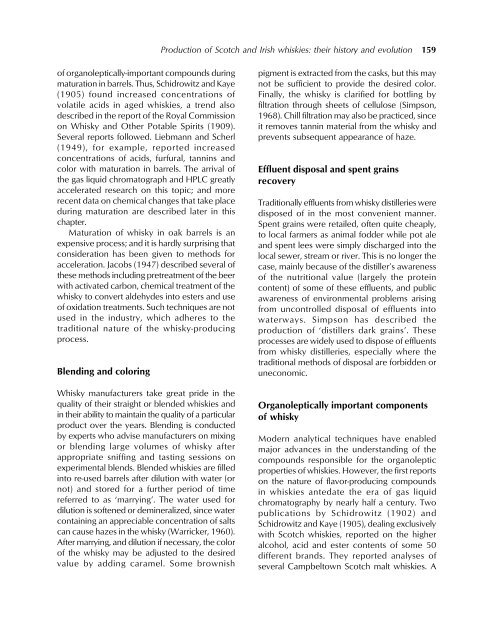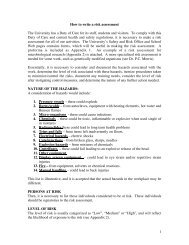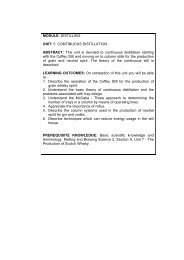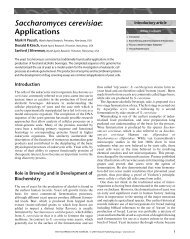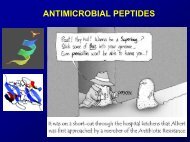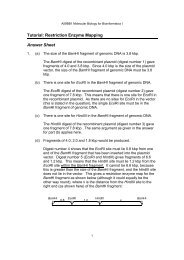Chapter 11 Production of Scotch and Irish whiskies: their history and ...
Chapter 11 Production of Scotch and Irish whiskies: their history and ...
Chapter 11 Production of Scotch and Irish whiskies: their history and ...
You also want an ePaper? Increase the reach of your titles
YUMPU automatically turns print PDFs into web optimized ePapers that Google loves.
<strong>Production</strong> <strong>of</strong> <strong>Scotch</strong> <strong>and</strong> <strong>Irish</strong> <strong>whiskies</strong>: <strong>their</strong> <strong>history</strong> <strong>and</strong> evolution 159<strong>of</strong> organoleptically-important compounds duringmaturation in barrels. Thus, Schidrowitz <strong>and</strong> Kaye(1905) found increased concentrations <strong>of</strong>volatile acids in aged <strong>whiskies</strong>, a trend alsodescribed in the report <strong>of</strong> the Royal Commissionon Whisky <strong>and</strong> Other Potable Spirits (1909).Several reports followed. Liebmann <strong>and</strong> Scherl(1949), for example, reported increasedconcentrations <strong>of</strong> acids, furfural, tannins <strong>and</strong>color with maturation in barrels. The arrival <strong>of</strong>the gas liquid chromatograph <strong>and</strong> HPLC greatlyaccelerated research on this topic; <strong>and</strong> morerecent data on chemical changes that take placeduring maturation are described later in thischapter.Maturation <strong>of</strong> whisky in oak barrels is anexpensive process; <strong>and</strong> it is hardly surprising thatconsideration has been given to methods foracceleration. Jacobs (1947) described several <strong>of</strong>these methods including pretreatment <strong>of</strong> the beerwith activated carbon, chemical treatment <strong>of</strong> thewhisky to convert aldehydes into esters <strong>and</strong> use<strong>of</strong> oxidation treatments. Such techniques are notused in the industry, which adheres to thetraditional nature <strong>of</strong> the whisky-producingprocess.Blending <strong>and</strong> coloringWhisky manufacturers take great pride in thequality <strong>of</strong> <strong>their</strong> straight or blended <strong>whiskies</strong> <strong>and</strong>in <strong>their</strong> ability to maintain the quality <strong>of</strong> a particularproduct over the years. Blending is conductedby experts who advise manufacturers on mixingor blending large volumes <strong>of</strong> whisky afterappropriate sniffing <strong>and</strong> tasting sessions onexperimental blends. Blended <strong>whiskies</strong> are filledinto re-used barrels after dilution with water (ornot) <strong>and</strong> stored for a further period <strong>of</strong> timereferred to as ‘marrying’. The water used fordilution is s<strong>of</strong>tened or demineralized, since watercontaining an appreciable concentration <strong>of</strong> saltscan cause hazes in the whisky (Warricker, 1960).After marrying, <strong>and</strong> dilution if necessary, the color<strong>of</strong> the whisky may be adjusted to the desiredvalue by adding caramel. Some brownishpigment is extracted from the casks, but this maynot be sufficient to provide the desired color.Finally, the whisky is clarified for bottling byfiltration through sheets <strong>of</strong> cellulose (Simpson,1968). Chill filtration may also be practiced, sinceit removes tannin material from the whisky <strong>and</strong>prevents subsequent appearance <strong>of</strong> haze.Effluent disposal <strong>and</strong> spent grainsrecoveryTraditionally effluents from whisky distilleries weredisposed <strong>of</strong> in the most convenient manner.Spent grains were retailed, <strong>of</strong>ten quite cheaply,to local farmers as animal fodder while pot ale<strong>and</strong> spent lees were simply discharged into thelocal sewer, stream or river. This is no longer thecase, mainly because <strong>of</strong> the distiller’s awareness<strong>of</strong> the nutritional value (largely the proteincontent) <strong>of</strong> some <strong>of</strong> these effluents, <strong>and</strong> publicawareness <strong>of</strong> environmental problems arisingfrom uncontrolled disposal <strong>of</strong> effluents intowaterways. Simpson has described theproduction <strong>of</strong> ‘distillers dark grains’. Theseprocesses are widely used to dispose <strong>of</strong> effluentsfrom whisky distilleries, especially where thetraditional methods <strong>of</strong> disposal are forbidden oruneconomic.Organoleptically important components<strong>of</strong> whiskyModern analytical techniques have enabledmajor advances in the underst<strong>and</strong>ing <strong>of</strong> thecompounds responsible for the organolepticproperties <strong>of</strong> <strong>whiskies</strong>. However, the first reportson the nature <strong>of</strong> flavor-producing compoundsin <strong>whiskies</strong> antedate the era <strong>of</strong> gas liquidchromatography by nearly half a century. Twopublications by Schidrowitz (1902) <strong>and</strong>Schidrowitz <strong>and</strong> Kaye (1905), dealing exclusivelywith <strong>Scotch</strong> <strong>whiskies</strong>, reported on the higheralcohol, acid <strong>and</strong> ester contents <strong>of</strong> some 50different br<strong>and</strong>s. They reported analyses <strong>of</strong>several Campbeltown <strong>Scotch</strong> malt <strong>whiskies</strong>. A


